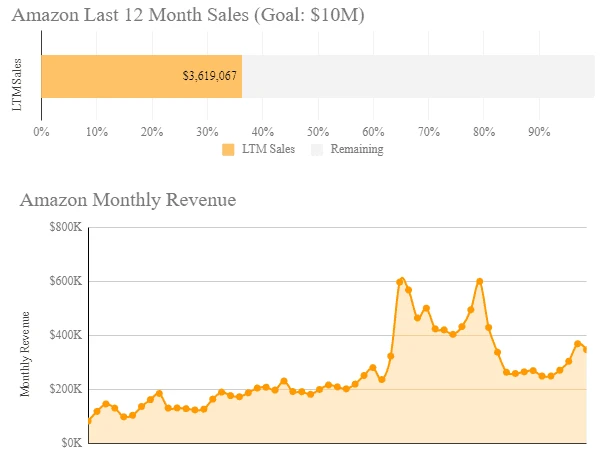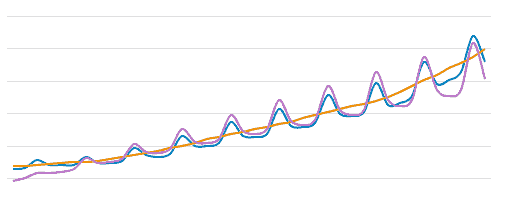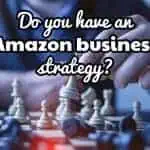
Here’s the current Gorilla ROI Amazon sales progress. To see the interactive version, go to our income reports page.
Note: These monthly updates are for educational purposes only.
Article Summary (TL;DR)
✅ Explore the performance metrics and milestones achieved in January for our FBA business, reaching $347K in sales.
✅ Gain insights into the challenges faced and lessons learned during the month, highlighting opportunities for improvement and future growth.
✅ Learn about the strategies implemented to drive sales growth, including inventory management, pricing optimization, and marketing efforts.
December Stats
- $369k in sales.
- Down vs last year.
- Up vs prior month.
- -25% from the same month last year
- +21% change from the previous month
- Conversion rate of 33.5% vs 31.1% the previous month
- Session value increased to $6.91 (sales ÷ sessions) vs $6.02 prior month
- ACoS decreased to 30.3%.
- TACoS still too high at 15.5%.
- This month Sales to Inventory ratio was 1.43
- Last month Sales to Inventory ratio was 1.28
Short version: December is always the best month for everyone. If it went the opposite direction in December, then that’s really worrisome.
The Previous Year’s Total Stats
- $3.9M in sales.
- -25% change from the previous year
- Conversion rate of 32.3% vs 27.5% previous year
- Session value average $5.65 (sales ÷ sessions) vs $4.42 previous year
- TACoS ballooned to 14.34% vs 8.35%… ouch. Lost 6% margin here.
- GMROI (Gross Margin to Inventory) is an annual number I measure.
GMROI = GROSS PROFIT / INVENTORY
The higher the GMROI, the quicker your inventory turnover is, and your cash is not being locked up in inventory.
The lower the GMROI, the slower you are selling and more cash is being locked up.
In retail, a rule of thumb is to have a GMROI from 2.5 to 3.2
This means that for every $1 of inventory, it generates $2.5 to $3.2 in gross profit.
2021 GMROI for us came in at 5.74 which is lower than last year of 9.14.
Here’s a look at how public companies perform in this metric for 2021 or TTM (trailing twelve months).
- Proctor & Gamble (PG) annual GMROI = 5.8
- 3M (MMM) annual GMROI = 3.3
- Helen of Troy (HELE) annual GMROI = 1.6
- Nike (NKE) annual GMROI = 3.3
- Target (TGT) annual GMROI = 2.0
- Apple (AAPL) annual GMROI = 27.7
- Hanesbrand (HBI) annual GMROI = 1.7
- GoPro (GPRO) annual GRMOI = 5.5
Again, Apple just kills it with an exceptional GMROI of 27.7. That’s elite. Their brand is so strong, they can easily charge a premium. Apple’s brand strength means they can easily price their product 3-5x higher than the competition.
Goes to show how important brand strength and image are, but that’s easier said than done.
Overall, considering all the ups and downs of the previous year, I’m pleased with how the year ended, but with a lower GMROI, I could definitely feel a tighter squeeze on the bank account than in 2020.
January Stats
- $347k in sales.
- Down vs last year.
- Down vs prior month.
- -42% from the same month last year
- -6% change from the previous month
- Conversion rate of 31.4% vs 33.5% the previous month
- Session value decreased to $6.09 (sales ÷ sessions) vs $6.91 prior month
- ACoS decreased to 26.6%.
- TACoS decreased to 13.2% – and focusing to bring it down further
- This month Sales to Inventory ratio was 0.87
- Last month Sales to Inventory ratio was 1.43
Phew. 3 months of stats caught up.
Side note: I’ve been focusing on SEO traffic on our Amazon seller blog which is why I haven’t written many reports lately. Google no longer rewards unique or interesting content. They just want” search intent” related articles which is why nearly every blog you read has no personality. It’s just the way it is. So if you don’t see my reports for a couple of months, it’s because I’m posting stuff related to what people are searching for on Google.
With sales to inventory, the higher the better.
If it goes up, it means:
- Sales increased OR
- Inventory value decreased OR
- Sales increased AND inventory value decreased
But in Jan, we’ve dipped below 1 which means:
- Sales decreased OR
- Inventory increased OR
- Sales decreased AND inventory value increased
The sales to inventory ratio drop in Jan was largely driven as a result of #2 above. We finally got a couple of containers that should have arrived in December, and of course, we had to order more 2-3x more so as not to deal with the manipulated shipping going on.
Current inventory levels are the highest we’ve ever had, but as I’ve been beating on since 2019, I don’t see this easing up for several years. Best case scenario will be 2 years.
Wins of the Previous Year

Looking over the year and how we ended, there are plenty of highlights and plenty of lowlights.
Let’s start with the good first.
Forecasting and data

This is where we excel the most as we have a strong grasp of our data, and we focus on reading between the lines to detect actionable and insightful data. Info that helps us understand the health and status of the business and to do something about it.
The sales velocity calculations, lead time calculations and demand planning we do isn’t rocket science. There’s no reason to overcomplicate things, but using Amazon’s data directly without adjustment has always led us into trouble. Hence, why we don’t bother looking at any of their performance or restocking reports and metrics.
I truly don’t understand why Amazon would use a linear last 30 days calculation for all of their estimates and recommendations. No seasonality factored in, no spikes smoothed out. They have intense algorithms to suspend your account, lower your IPI, red flag your account, but when it comes to recommendations, it’s just the last 30 days to run your business.
Our strength is still very much on data and analysis to drive our decisions.
Keeping operational debt low

The Goal is a classic business book that shows the importance of reducing operational debt.
Operational debt is anything that makes your business messy that reduces efficiency and output.
- clunky systems
- bad data that you have to recheck manually
- lots of touch points
- requiring lots of middlemen
- low to no automation
- inefficient processes
- digital junk and clutter
- people not being able to find important info when needed
- and so on
I instill into the team to keep operational debt as low as possible and if there’s something that makes the process inefficient or hard to get done, it needs to be fixed.
This means, I’m always evaluating whether the current systems and methods we use are up to standard, whether we aren’t adapting to new software or methods that could lighten the workload.
Many people say just hire more VA’s. I disagree.
The more you hire, the more you have to manage. I want to be able to streamline and keep things lean so that only the vital people are needed. And when you don’t clear out the clutter, it makes the problem X times worse the following year or many years later when you really have to change something in your business. It’s a nightmare to fix later rather than soon.
For example, a big change that was made was completely switching our entire system from Trello -> Infinity App (another project management software) -> Notion.
Took about 1.5 months to get set up and running, but now that it’s up, we are good to go. Eliminated a lot of troubles related to not being able to make work visible across the company and different timezones.
Another massive change was updating our website which took 3 months of planning, doing, testing, and launching.
We have dedicated VPS solutions that we use in order to increase reliability and speed.
New website and SEO
This falls into the Jan 2022 update instead as we relaunched our new site in late Jan. But the whole process started in later October/Nov of 2021.
It’s still early, but ever since I put more effort and resources into growing traffic and our website, data is showing good signs and sales are coming along. I’ve always been into SEO. I find it a fun game to play. Pretty much like finding what works on Amazon, but doing it with Google and without having to worry about the BS that Amazon throws at you.
Here’s a little case study for our e-commerce store of doing everything most SEOers say shouldn’t be done.
Summary of outcome
- Traffic remains the same
- number of new keywords are up
- keyword rankings are up
- conversions are up
- new article indexing speed is up
If you use Ahrefs, then here’s our screenshot of some of the keywords that we are targeting.

The initial problem with our website
Our site is a woocommerce e-commerce store and was only doing $1500 ~ $2000/mo depending on the season. Not a huge seller and because it wasn’t earning at least 5 figures, I didn’t spend much time or effort on it because the Amazon side of things dwarfs it in comparison.
The site was slow as we built on top of a page builder called Brizy. So much bloat.
Decided to use Gutenberg + Kadence to improve speed as Google rolled out their Core Web Vitals measurement metrics.
But as I was redoing things, I figured I might as well tear apart everything and rebuild it from the ground up. The domain was 7 years old, the design was starting to look tired and I wanted to get serious about the site with the goal of getting sales to $10k/mo as the first major milestone.
Problems uncovered
Inbound marketing comes easy for us as I’ve been in the SEO game for so long. But as I was peeling back the onion on the website, I found lots of issues (all become operational debt if not resolved).
- too many redundant articles
- no clear keyword siloing and structure
- lots of duplicate and competing keywords for our catalog of products E.g. a product page for a razor was targeting “razor”, then another page for another “razor + soap bundle” is also targeting “razor”.
- long ugly URLs
After gathering all the faults, I grouped them into the main problems and it came down to 3 core issues
- “homemade” feeling design – not up to today’s standard
- bad structure
- duplicate keywords across pages and posts
The site speed and core web vitals weren’t the important things. It would be solved naturally with the new site built on Gutenberg anyways.
Important intermission
“If I only had an hour to chop down a tree, I would spend the first 45 minutes sharpening my axe.”
Abraham Lincoln
I’m simplifying here but it’s really not hard. I don’t like to overcomplicate things and get caught up in the minor details that don’t help your site or your business.
I hate reinventing the wheel. I take this and that from other ecommerce sites that are killing it and apply it to mine.
It’s exactly what you likely do with your Amazon listings and products. Just apply it to your website.
As we converted our project management system to Notion, I started to classify everything into importance and urgency.
If a task is categorized as not important and not urgent, -> never do it.
I find that most business owners waste most of their time on not important & not urgent tasks.
In the software world, it’s called agile development. Launch something quickly and keep improving and iterating on it based on feedback.
Back to the topic.
The design process
- Like the Lincoln quote above, I spent most of the time researching, prepping, learning and planning. The doing is the easiest part.
- Started with the design. Took structure and wireframe ideas from sites like www.security.org and other really good niche sites.
- Color palette is super important to build trust. I wanted to get away from the typical white site that everyone has. Went with a lush deep forestry green as our products are premium and high quality in the industry.
- Ended up using a color scheme very similar to shopify.com

- Don’t use more than 2 main colors. Overusing colors makes your site look cheap and homemade like my previous one.I create lots of reusable blocks in Gutenberg so that I can quickly reuse it and insert it into new pages without having to redesign things from scratch. Use Global blocks wherever you can to make it easier.
The structure process
- Reduced all categories down to 4, but the bulk of the articles were moved to 2 silos. No more messy categories. This includes all posts and product pages.
- Simplified the navigation – make pages reachable within 2 (max 3 clicks)
- installed Jetpack search (One of the best WordPress plugin purchases I think) – makes UX soooo much better
Keyword optimization
- Exported all the articles and product pages and did a keyword audit. Then reassigned the keyword for each listing.
- DELETED crap articles and redirected
- MERGED weaker duplicate articles into the better ranking article and redirected
- CHANGED the URL to use the keyword and redirected
- OPTIMIZED the top pages and money pages using Surfer SEO to get the scores and onpage optimization scores up
Final results
We only launched about a month ago at the time of this writing, but the results are clear already.
- Sales up 90% in the 4 weeks since launch compared to last year
- Conversation rate is up 50%
- New articles are indexed on Google very quickly
- More people reaching out to us for link exchanges
- Site is gaining more authority
If I can keep this momentum going and start spending on PPC to get warmer traffic, I really think the $10k mark is achievable finally.
We did pretty much everything most SEO people say not to do with a site, but sometimes you can only polish a turd so much.
The only reason I was wasn’t afraid of doing all this is because our ecom site is a tiny fraction of our overall sales so even if I severely mess things up, it wasn’t going to put us out of business. If you are doing 5 or 6 figures a month, then the risk is much higher and needs to be planned out better and done incrementally.
Like our content? Follow our journey to reach $10M in sales
We share our real failures, wins, and what we are doing on our journey from $0 to $10M in sales.
Fails of the Previous Year

Going back through my past monthly posts brings up a lot of frustrating memories haha.
Supplier woes
I won’t rehash the whole saga as it’s all there in the monthly income reports.
The short version is that we have one product that we resell from a fairly well-known brand. When we first started, their presence on Amazon sucked and they didn’t sell much. We took their one product and turned it into $2M in sales for them.
But out of the blue, we are hit with a “sold used as new” complaint which took down the main listing and the majority of revenue. We didn’t get that listing reactivated but kept going and were starting to get things back up to where they were.
Until we are given notice by the supplier that they were going to directly handle the Amazon channel and they will no longer supply to us.
So that’s why the revenue and sales have been dropping on our Amazon business since the previous year as we no longer had orders fulfilled and only had the remaining units to sell through.
By March of this year, we’ll have gotten rid of all their inventory and shake the dust from my feet once I’m done with them.
Growing the sales from this product to about 40%ish of our revenue was nice, but a huge risk and now we are paying for it.
Failed products
This is where things got worse.
Knowing that we were going to stop carrying the product from the supplier above, we quickly got in touch with another loyal supplier and started developing our own version of the product.
Product performance came out even better than the original and the product launch was a success.
We were ranking, sales were going up and we ordered a huge amount of inventory because we could see this starting to rise quickly.
But then we started getting bad review… after bad review.
I thought to myself it was the typical “Amazon customer” complaining about everything and not knowing how to use the product.
Well, it turns out that although the performance was great, we were in such a rush to get to market, we didn’t spend enough time to test the stability of the product.
This is a cleaning solution and the cleaning agents started to sit at the bottom of the bottle and get stuck. The usable shelf life went from 3 years, down to 5 months.

And now I have thousands of bottles that are useless.
This was completely on us and so we lost a lot of money on this one.
Lesson?
Anything worth doing, is worth doing right.
Someone
We ended the year with more failed products than winners which didn’t help. We lost even more in really competitive industries. You need really deep pockets to compete and have to endure the pain of losing money for a much longer period if the category is super tough.
We didn’t have the confidence to be able to break through as we were fighting against giants and conglomerates.
As much as our operational data and analysis are top-notch, our research and competitor analysis needs to improve in a big way.
Supply chain
The big X factor is still the time it takes for the shipment. No matter how accurate I thought our lead times and demand planning were, something always got screwed up that was beyond our control.
One container arrives in Seattle, gets unloaded at the wrong terminal, pushed back into the corner of the yard because Walmart and Costco arrived. And then it never got dug out again.
If you start talking to more freight forwarders, you’ll hear how their customers are pushed back, delayed, or simply lost while ports give priority to the conglomerates. It’s just ridiculous.
For 2 months our calls to the terminal, emails, threats were all ignored until my wife tracked down the CEO of the company and gave him an earful and insinuated going to the media about it.
Do you know what happened?
Our container “magically” was dug out of the corner of a yard they said couldn’t be reached for the past 2 months, and was delivered to us in 2 days.
Shipments from Vietnam have been the worst actually.
We added 2 months to the total shipment time, but in reality, it’s so volatile, and we’ve had containers take 3 months to get here.
Our bookings were locked in, only to find it has been canceled, and then we are forced to pay the extra premium rate if we wanted to secure a booking.
Supply and demand? Pfft. Yeah right.
There’s so much collusion going on in the shipping industry right now. And it’s the small guys who are fighting tooth and nail while the big corps get the white-glove treatment.
Collusion is so obvious in the shipping industry.
Product development times
Something really hit home for our management team.
We’ve always been on the brand-building bandwagon, but I believe that we’ve overthought and overcomplicated it. Rather than quickly testing products to see what the market wants, we spend 1 year developing and then if it flops, we just wasted a ton of resources and time.
I should be in the business of making money.
There’s no glory in having a million patents next to my name with no sales to show for it. I see how stubborn we’ve been when I see new sellers ramping up to 7 figures in a year while we are showing a decline the past year.
Sales cures all.
This does not mean I’m going to sell anything and become a flea market. But it does mean, I’m going to loosen up the restrictions of what we do and don’t sell. To get better at sourcing quality products and improving speed to market and win rates with product launches.
Everyone talks about building a brand, and who doesn’t want to do that right?
But I find it really hard in the category that we are in and being a data nerd, trying to justify brand building is tough because there’s no way to measure it.
- How do you measure whether you have a brand?
- How do you compare your brand vs competitors?
- What stats show your sales is due to brand recognition?
With consumer trends changing so quickly, is a brand really riding a trend, or even if trends change, will people keep coming to your product without even thinking about other alternatives?
It just takes years and years of money spent on advertising and getting it in front of people’s faces until something goes viral or it gets noticed by someone with influence to push it.
And maybe it’s because my opinion of brands is like this that we don’t have a big brand?
What do you think?
Goals for This Year

Offset the lost revenue with new products
Two new products that took 1 year to develop is finally on Amazon and it’s selling as soon as it the shelves. This one I’m confident in as it’s right up in our wheelhouse. It’s also priced in the $30-$40 range and not in our usual $15-$20 bracket.
Losing that major brand happened for the right reasons. If we were at $10M, and made up 40% of the business, that would have done far greater damage.
Now with my head out of my rear end and no longer being distracted with the drama, I’m super pumped about the new products and suppliers we’ve lined up.
We are now switching from an OEM business model to a true private labeling business (not from China). This will bring our time to market from 1~1.5 years to 3~6months. POs have been submitted for 6 new SKUs set to come in a couple of months.
Shipping times
It’s a goal, but not sure how realistic it will be if we can’t control it. The last container, we put in an order 2 months ahead on top of our extended 5 month lead time. So that is 7 months of money tied up, but it STILL came 2 months late.
Fatten margins
This year isn’t about growing our top line. I’ve flipped the switch and moved completely to playing defense and fattening margins. Even with new product launches, I’m setting a fairly high margin to make sure it’s sustainable.
Inflation, stupid money policies, war, raw materials, higher employment costs, shipping.
Now is the time to fatten the bank account and build up reserves as much as possible.
At the end of the year, we raised prices 15% to 25% across the board. I’m willing to sell less, to make more. High volume with low margins is not a game I want to play during times like this.
Getting my ad spend down is also another priority. Now that I’ve pulled the failing products with ACOS of 80%+, the spend has come back to normal levels. There was an unprofitable month last year due to the crazy competitiveness of the niche.
We’ve since pulled it all out, found some micro niches to relaunch into and so far, one of them looks like it will do well.
1. Prepare for the worst. Hope for the best. 2. Build a business for the long term.
Where I think Amazon marketplace is heading
Suppliers will control more
Just like how my supplier pulled the rug from under us, if you resell brands, diversify, or have a very strong agreement in place.
Manufacturers have now become retailers in the new world of online commerce. With Amazon taking up the majority of online sales, and still no #2 platform in sight, if your business is centered on reselling other brands, your work will be to focus on keeping a steady stream of new brands to sign on.
Amazon ad spending will increase
It’s obvious that Amazon is intent on coming up with more and more advertising “features”.
- Organic results is getting close to non-existent
- Sponsored brands
- Sponsored products
- Sponsored editorials
- Sponsored videos
Soon, there’s going to be very little outside of advertising. Having a very good creative team is super important.
Videos to yield high returns
This is something that I actually like because you don’t have to spend a lot to make videos.
Look at current video trends (TikTok format) and create short clips with your phone. Post it on your listing and increase conversions.
It’s still something that many sellers overthink and think is expensive to do. We have some super high converting products in the 40-50% range where the video is just simple shots from my phone and stitched together with subtitles.
Amazon trying to get you to make Amazon your default store
Amazon is putting a lot of effort into getting you to try and make your Amazon store some sort of e-commerce hub. Don’t fall for it. Shoppers don’t care much and I haven’t seen a single data point that proves it’s important.
It’s actually more annoying from a UX (user experience) because if I go to a storefront, I just want to see in a list format the products they have. Not big image blocks or more sub menus to navigate.
Amazon Live and Amazon posts are still useless. I don’t see any engagement and if it doesn’t reward the influencer or whoever is creating it, why would you go off Instagram, TikTok to post on Amazon?
I’d rather spend that resource on our own website content, inbound marketing, or PPC.
Still dominant and no one close
The sad reality is that Amazon dominates the marketplace and there is no one close.
Walmart marketplace is still a mess and there is a cliff-like drop off between Amazon and Walmart. I don’t even know who the 3rd player is. We are on ebay, etsy, wayfair, but nothing worth writing about.
There’s talk about Shopify trying to do something, but it’s a completely different system and model which won’t affect Amazon.
Good luck with This Year
I’m interested to know your thoughts.
I’m no crystal ball reader or expert other than from what I can piece together here and there.
How was the previous year for you and what’s the top thing you are aiming for this year?
Comments
One response to “January Monthly Update at $347k”
-
Love this post, and your thoughts overall. keep them coming
Related Posts
Smart Guide to Import Amazon Data to Google Sheets
Running an Amazon business means juggling dozens of moving parts:…
The ultimate guide to Shopify marketing attribution: what works best for your business?
What you’ll learn Have you ever wondered where your customers…
Top 5 Strategies to Sustainable Shopify Growth: Turning One-Time Buyers into Lifetime Customers
What you’ll learn As a Shopify seller, you’re constantly looking…








Leave a Reply